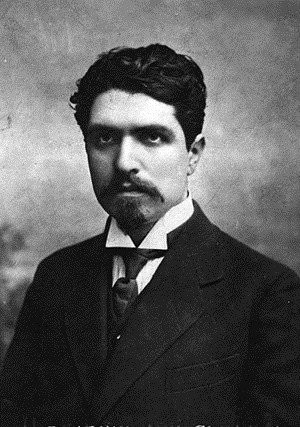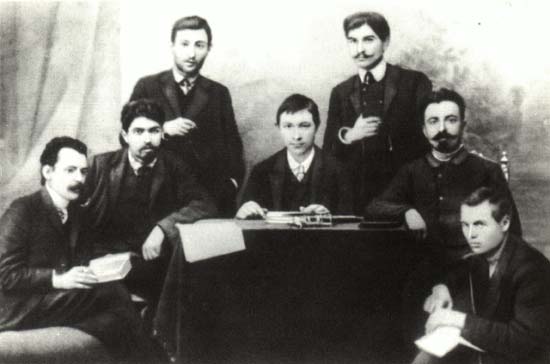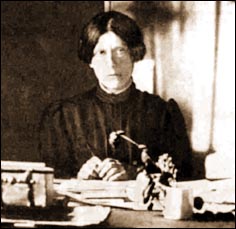|
26 Baku Commissars
The 26 Baku Commissars were Bolshevik and Left Socialist Revolutionary (SR) members of the Baku Commune. The commune was established in the city of Baku, which was then the capital of the briefly independent Azerbaijan Democratic Republic, and is now the capital of the Republic of Azerbaijan. The commune, led by Stepan Shahumyan, existed until 26 July 1918 when the Bolsheviks were forced out of power by a coalition of Dashnaks, Right SRs, and Mensheviks. After their overthrow, the Baku commissars attempted to leave Baku but were captured by the Centrocaspian Dictatorship and imprisoned. On 14 September 1918, during the fall of Baku to Ottoman forces, Red Army soldiers broke into their prison and freed the commissars; they then boarded a ship to Krasnovodsk, where they were promptly arrested by local authorities and, on the night of 20 September 1918, executed by a firing squad between the stations of Pereval and Akhcha-Kuyma on the Transcaspian Railway by soldiers of the As ... [...More Info...] [...Related Items...] OR: [Wikipedia] [Google] [Baidu] |
Baku
Baku (, ; az, Bakı ) is the capital and largest city of Azerbaijan, as well as the largest city on the Caspian Sea and of the Caucasus region. Baku is located below sea level, which makes it the lowest lying national capital in the world and also the largest city in the world located below sea level. Baku lies on the southern shore of the Absheron Peninsula, alongside the Bay of Baku. Baku's urban population was estimated at two million people as of 2009. Baku is the primate city of Azerbaijan—it is the sole metropolis in the country, and about 25% of all inhabitants of the country live in Baku's metropolitan area. Baku is divided into twelve administrative raions and 48 townships. Among these are the townships on the islands of the Baku Archipelago, and the town of Oil Rocks built on stilts in the Caspian Sea, away from Baku. The Inner City of Baku, along with the Shirvanshah's Palace and Maiden Tower, were inscribed as a UNESCO World Heritage Site in 2000. The c ... [...More Info...] [...Related Items...] OR: [Wikipedia] [Google] [Baidu] |
Battle Of Baku
The Battle of Baku ( az, Bakı döyüşü, tr, Bakü Muharebesi, russian: Битва за Баку) was a battle in World War I that took place between August–September 1918 between the Ottoman– Azerbaijani coalition forces led by Nuri Pasha and Bolshevik–ARF Baku Soviet forces, later succeeded by the British–Armenian– White Russian forces led by Lionel Dunsterville and saw Soviet Russia briefly re-enter the war. The battle was fought as a conclusive part of the Caucasus Campaign, but as a beginning of the Armenian–Azerbaijani War. Background In 1917, the Russian Caucasus Front collapsed following the abdication of the Tsar. On 9 March 1917, the Special Transcaucasian Committee was established to fill the administrative gap in areas occupied in the course of the war on the Caucasian front by the Russian Provisional Government in the Transcaucasia. This administration, which included representatives of Armenian, Azerbaijani and Georgian groups, did not last l ... [...More Info...] [...Related Items...] OR: [Wikipedia] [Google] [Baidu] |
Prokofy Dzhaparidze
Prokofy "Alyosha" Aprasionovich Dzhaparidze or Japaridze, ( ka, პროკოფი აპრასიონის ძე ჯაფარიძე, russian: Прокофий Апрасионович Джапаридзе; 15 January 1880 – 20 September 1918), was a Georgian revolutionary activist, one of the Red Army and Bolshevik Party leaders in Azerbaijan during the Russian Revolution. Dzhaparidze, an ethnic Georgian joined to Bolsheviks in 1898 where he earned the nickname ''Alyosha'' (''Alesha''), then moved to Baku. Helping the founding of the Azerbaijani socialist party Hummet, he became Delegate of the Caucasian Union of the RSDLP at the 3rd Congress of the RSDLP in London. During his political life, he was many times arrested or exiled for his anti-tsarist activities in Russian Empire. After the February Revolution he became a member of the Caucasian Regional Committee, joined the Baku Commune and became one of the legendary 26 Baku Commissars. He took several differe ... [...More Info...] [...Related Items...] OR: [Wikipedia] [Google] [Baidu] |
Stepan Shaumian
Stepan Georgevich Shaumian (; , ''Step’an Ge'vorgi Shahumyan''; 1 October 1878 – 20 September 1918) was a Bolshevik revolutionary and politician active throughout the Caucasus. Arzumanyan, M. Շահումյան, Ստեփան Գևորգի. "Yerevan, Armenian SSR, vol. viii", ''The Soviet Armenian Encyclopedia'', 1982, pp. 431–34 Shahumyan was an ethnic Armenian and his role as a leader of the Russian revolution in the Caucasus earned him the nickname of the "Caucasian Lenin", a reference to the leader of the Russian Revolution, Vladimir Lenin. The founder and editor of several newspapers and journals, Shaumian is best known as the head of the Baku Commune, a short lived committee appointed by Lenin in March 1918 with the task of leading the revolution in the Caucasus and West Asia. His tenure as leader of the Baku Commune was marred with numerous problems including ethnic violence between Baku's Armenian and Azerbaijani populations, attempting to defend the city against a ... [...More Info...] [...Related Items...] OR: [Wikipedia] [Google] [Baidu] |
Left Socialist-Revolutionaries
The Party of Left Socialist-Revolutionaries (russian: Партия левых социалистов-революционеров-интернационалистов) was a revolutionary socialist political party formed during the Russian Revolution. In 1917, the Socialist Revolutionary Party split between those who supported the Russian Provisional Government, established after the February Revolution and those who supported the Bolsheviks, who favoured the overthrow of the Provisional Government and the placing of political power in the hands of the Congress of Soviets. Those that continued to support the Provisional Government became known as the Right SRs while those who aligned with the Bolsheviks became known as the Left Socialist-Revolutionaries or Left SRs. After the October Revolution, the Left SRs formed a coalition government with the Bolsheviks from November 1917 to July 1918, but resigned its position in government after the signing of the Treaty of Brest-Litovsk ... [...More Info...] [...Related Items...] OR: [Wikipedia] [Google] [Baidu] |
Bolsheviks
The Bolsheviks (russian: Большевики́, from большинство́ ''bol'shinstvó'', 'majority'),; derived from ''bol'shinstvó'' (большинство́), "majority", literally meaning "one of the majority". also known in English as the Bolshevists,. It signifies both Bolsheviks and adherents of Bolshevik policies. were a far-left, revolutionary Marxist faction founded by Vladimir Lenin that split with the Mensheviks from the Marxist Russian Social Democratic Labour Party (RSDLP), a revolutionary socialist political party formed in 1898, at its Second Party Congress in 1903. After forming their own party in 1912, the Bolsheviks took power during the October Revolution in the Russian Republic in November 1917, overthrowing the Provisional Government of Alexander Kerensky, and became the only ruling party in the subsequent Soviet Russia and later the Soviet Union. They considered themselves the leaders of the revolutionary proletariat of Russia. Their beli ... [...More Info...] [...Related Items...] OR: [Wikipedia] [Google] [Baidu] |
Victor Serge
Victor Serge (; 1890–1947), born Victor Lvovich Kibalchich (russian: Ви́ктор Льво́вич Киба́льчич), was a Russian revolutionary Marxist, novelist, poet and historian. Originally an anarchist, he joined the Bolsheviks five months after arriving in Petrograd in January 1919 and later worked for the Comintern as a journalist, editor and translator. He was critical of the Stalinist regime and remained a revolutionary Marxist until his death. He is best remembered for his '' Memoirs of a Revolutionary'' and series of seven "witness-novels" chronicling the lives of Soviet people and revolutionaries and of the first half of the 20th century. Works available in English Fiction * ''The Long Dusk'' or ''Last Times'' (1946) Translator: Ralph Manheim; New York : The Dial Press. Translation of ''Les dernier temps'', Montreal 1946. * ''The Case of Comrade Tulayev'' (1967) Translator: Willard R. Trask; New York : New York Review of Books Classics. Translation of ' ... [...More Info...] [...Related Items...] OR: [Wikipedia] [Google] [Baidu] |
Nationalization
Nationalization (nationalisation in British English) is the process of transforming privately-owned assets into public assets by bringing them under the public ownership of a national government or state. Nationalization usually refers to private assets or to assets owned by lower levels of government (such as municipalities) being transferred to the state. Nationalization contrasts with privatization and with demutualization. When previously nationalized assets are privatized and subsequently returned to public ownership at a later stage, they are said to have undergone renationalization. Industries often subject to nationalization include the commanding heights of the economy – telecommunications, electric power, fossil fuels, railways, airlines, iron ore, media, postal services, banks, and water – though, in many jurisdictions, many such entities have no history of private ownership. Nationalization may occur with or without financial compensation to the former owners. ... [...More Info...] [...Related Items...] OR: [Wikipedia] [Google] [Baidu] |
Ottoman Empire
The Ottoman Empire, * ; is an archaic version. The definite article forms and were synonymous * and el, Оθωμανική Αυτοκρατορία, Othōmanikē Avtokratoria, label=none * info page on book at Martin Luther University) // CITED: p. 36 (PDF p. 38/338) also known as the Turkish Empire, was an empire that controlled much of Southeast Europe, Western Asia, and Northern Africa between the 14th and early 20th centuries. It was founded at the end of the 13th century in northwestern Anatolia in the town of Söğüt (modern-day Bilecik Province) by the Turkoman tribal leader Osman I. After 1354, the Ottomans crossed into Europe and, with the conquest of the Balkans, the Ottoman beylik was transformed into a transcontinental empire. The Ottomans ended the Byzantine Empire with the conquest of Constantinople in 1453 by Mehmed the Conqueror. Under the reign of Suleiman the Magnificent, the Ottoman Empire marked the peak of its power and prosperity, as well a ... [...More Info...] [...Related Items...] OR: [Wikipedia] [Google] [Baidu] |
Muslims
Muslims ( ar, المسلمون, , ) are people who adhere to Islam, a monotheistic religion belonging to the Abrahamic tradition. They consider the Quran, the foundational religious text of Islam, to be the verbatim word of the God of Abraham (or '' Allah'') as it was revealed to Muhammad, the main Islamic prophet. The majority of Muslims also follow the teachings and practices of Muhammad ('' sunnah'') as recorded in traditional accounts (''hadith''). With an estimated population of almost 1.9 billion followers as of 2020 year estimation, Muslims comprise more than 24.9% of the world's total population. In descending order, the percentage of people who identify as Muslims on each continental landmass stands at: 45% of Africa, 25% of Asia and Oceania (collectively), 6% of Europe, and 1% of the Americas. Additionally, in subdivided geographical regions, the figure stands at: 91% of the Middle East–North Africa, 90% of Central Asia, 65% of the Caucasus, 42% of Southeast Asi ... [...More Info...] [...Related Items...] OR: [Wikipedia] [Google] [Baidu] |
Islamic Army Of The Caucasus
The Islamic Army of the Caucasus ( az, Qafqaz İslam Ordusu; Turkish: ''Kafkas İslâm Ordusu'') (also translated as ''Caucasian Army of Islam'' in some sources) was a military unit of the Ottoman Empire formed on July 10, 1918. The Ottoman Minister of War, Enver Pasha, ordered its establishment, and it played a major role during the Caucasus Campaign of World War I. Background During 1917, due to the Russian Revolution and subsequent Civil War, the Russian army in the Caucasus had ceased to exist. The Russian Provisional Government's Caucasus Front formally ceased to exist in March 1918. Meanwhile, the Committee of Union and Progress moved to win the friendship of the Bolsheviks with the signing of the Ottoman-Russian friendship treaty (January 1, 1918). On January 11, 1918, the special decree ''On Armenia'' was signed by Lenin and Stalin which armed and repatriated over 100,000 Armenians from the former Tsar's Army to be sent to the Caucasus for operations against Ottoman i ... [...More Info...] [...Related Items...] OR: [Wikipedia] [Google] [Baidu] |
Ashkhabad Committee
The Transcaspian Government (1918 - July 1919) was a "Menshevik-Socialist Revolutionary" coalition set up by the Railway workers of the Trans-Caspian Railway in 1918. It was based at Ashgabat, Transcaspian Oblast. Origin Autonomous sentiments were developing amongst the local Turkmen population, with the formation of the Turkmen National Army (TNA) in February 1918. Concerned about this, the Bolshevik Ashgabat Soviet appealed to , leader of the Tashkent Soviet for military support, and declared it would carry out a census of all arms-bearing men in the Russian majority town on 17 June 1918. However, this sparked off two days of rioting. The Tashkent Soviet dispatched some Red Guards led by V. Frolov and a Cheka contingent who arrived on 24 June and disarmed the Turkmen Cavalry Squadron, which was the core of the TNA. Frolov declared martial law and personally shot the five members of a delegation of railwaymen that had tried to present a petition to him. He proceeded to Kizyl-Ar ... [...More Info...] [...Related Items...] OR: [Wikipedia] [Google] [Baidu] |







